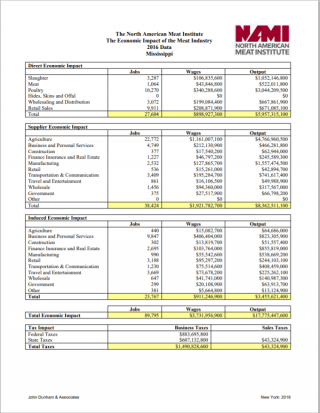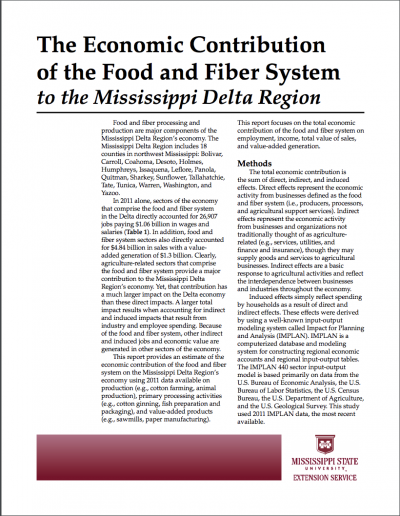Mississippi
State Quick Facts
Population
2,939,690
Total State GDP
$139,976,400,000
State Land Area (Acres)
30,030,720
Land in Forest (Acres)
19,237,922
Land in Forest
64%
Land in Farms (Acres)
10,300,000
Land in Farms
34%
Number of Farms
31,100
Average Farm Size (acres)
331
Farm Real Estate Value (per acre)
$3,060
Agricultural Cash Receipts
$7,831,624,000
Cash Receipts from Crops
$3,190,008,000
Cash Receipts from Animals
$4,641,615,000
Top Ag. Commodities
Broilers
$3,770,487,000
Soybeans
$1,725,051,000
Corn
$672,115,000
Cotton Lint, Upland
$393,447,000
Chicken Eggs
$298,777,000
Top Ag. Exports
Soybeans
$867,072,553
Cotton
$484,592,191
Broiler Meat
$309,541,602
Other Livestock Products
$199,272,697
Soybean Meal
$154,410,871
Alabama | Alaska | Arizona | Arkansas | California | Colorado | Connecticut | Delaware | Florida | Georgia | Hawaii | Idaho | Illinois | Indiana | Iowa | Kansas | Kentucky | Louisiana | Maine | Maryland | Massachusetts | Michigan | Minnesota | Mississippi | Missouri | Montana | Nebraska | Nevada | New Hampshire | New Jersey | New Mexico | New York | North Carolina | North Dakota | Ohio | Oklahoma | Oregon | Pennsylvania | Rhode Island | South Carolina | South Dakota | Tennessee | Texas | Utah | Vermont | Virginia | Washington | West Virginia | Wisconsin | Wyoming
Mississippi Economic Contribution and Impact Research
In 2022, Mississippi generated around $7.8 billion in agricultural cash receipts with the highest valued commodities being broilers, soybeans, and corn. That same year, the value of Mississippi’s agricultural production and processing industries represented 6.6 percent of total state GDP. Some of the dollars generated by these industries end up being re-spent within the local economy, bringing additional value to the state through “multiplier effects.” Economic impact and contribution studies measure these effects, which can be broken down into direct, indirect, and induced economic effects.
Websites, reports, fact sheets, and articles related to the economic impacts and contributions of Mississippi’s food, fiber, and forest industries can be found below.
Websites:
Information related to Mississippi’s food, fiber, and forest industries can be found by visiting the following website(s):
File System Maintenance in Progress
We’re performing file system maintenance, and a few files may be unavailable right now. Please visit the Archives page to access available Contribution and Impact Research Documents. Thanks for your patience!Contribution and Impact Research Documents:
The following are current and historical studies, fact sheets, and articles related to Mississippi’s food, fiber, and forest industries. These can be viewed and/or downloaded by clicking the images or links below:
2013MS_Forest_Inventory_Southwest_Region_Mississippi-1i17xbn
2013MS_Mississippis_Forests-1ujuelr
2014MS_2013-2014_Forest_Inventory_Southeast_Region_Mississippi-2fqubdg
2015MS_2014-2015_Forest_Inventory_Central_Region_Mississippi-11v5ym5
2015MS_AFPA_State_Industry_Economic_Impact-2aynzgk
MS-2017-Fact-Sheet-AFPA-State-Indusrty-Economic-Impact-20260p1
MS2016-Report-Economic_Analysis_of_Animal-_Agriculture_2005-2015-1emx4t4
MS2016-Report-Overview_and_Economic_Contribution_of_the_Mississippi_Blueberry_Industry-12fuu9j

















